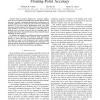Free Online Productivity Tools
i2Speak
i2Symbol
i2OCR
iTex2Img
iWeb2Print
iWeb2Shot
i2Type
iPdf2Split
iPdf2Merge
i2Bopomofo
i2Arabic
i2Style
i2Image
i2PDF
iLatex2Rtf
Sci2ools
CAL
2007
2007
Low-Cost Microarchitectural Support for Improved Floating-Point Accuracy
Abstract—Some processors designed for consumer applications, such as Graphics Processing Units (GPUs) and the CELL processor, promise outstanding floating-point performance for scientific applications at commodity prices. However, IEEE single precision is the most precise floating-point data type these processors directly support in hardware. Pairs of native floatingpoint numbers can be used to represent a base result and a residual term to increase accuracy, but the resulting order of magnitude slowdown dramatically reduces the price/performance advantage of these systems. By adding a few simple microarchitectural features, acceptable accuracy can be obtained with relatively little performance penalty. To reduce the cost of native-pair arithmetic, a residual register is used to hold information that would normally have been discarded after each floating-point computation. The residual register dramatically simplifies the code, providing both lower latency and better instructio...
CAL 2007 | CAL 2008 | IEEE Single Precision | Outstanding floating-point Performance | Residual Register |
| Added | 12 Dec 2010 |
| Updated | 12 Dec 2010 |
| Type | Journal |
| Year | 2007 |
| Where | CAL |
| Authors | William R. Dieter, A. Kaveti, Henry G. Dietz |
Comments (0)

